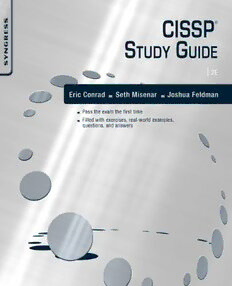Table Of Content®
CISSP Study Guide
Intentionally left as blank
®
CISSP Study Guide
Second Edition
Eric Conrad
Seth Misenar
Joshua Feldman
Technical Editor
Kevin Riggins
AMSTERDAM (cid:129) BOSTON (cid:129) HEIDELBERG (cid:129) LONDON
NEW YORK (cid:129) OXFORD (cid:129) PARIS (cid:129) SAN DIEGO
SAN FRANCISCO (cid:129) SINGAPORE (cid:129) SYDNEY (cid:129) TOKYO
Syngress is an imprint of Elsevier
AcquiringEditor:ChrisKatsaropoulos
DevelopmentEditor:HeatherScherer
ProjectManager:PaulGottehrer
Designer:JoanneBlank
SyngressisanimprintofElsevier
225WymanStreet,Waltham,MA02451,USA
#2012ElsevierInc.Allrightsreserved.
Nopartofthispublicationmaybereproducedortransmittedinanyformorbyanymeans,electronic
ormechanical,includingphotocopying,recording,oranyinformationstorageandretrievalsystem,
withoutpermissioninwritingfromthepublisher.Detailsonhowtoseekpermission,furtherinformation
aboutthePublisher’spermissionspoliciesandourarrangementswithorganizationssuchasthe
CopyrightClearanceCenterandtheCopyrightLicensingAgency,canbefoundatourwebsite:www.
elsevier.com/permissions.
ThisbookandtheindividualcontributionscontainedinitareprotectedundercopyrightbythePublisher
(otherthanasmaybenotedherein).
Notices
Knowledgeandbestpracticeinthisfieldareconstantlychanging.Asnewresearchandexperience
broadenourunderstanding,changesinresearchmethodsorprofessionalpractices,maybecomenecessary.
Practitionersandresearchersmustalwaysrelyontheirownexperienceandknowledgeinevaluating
andusinganyinformationormethodsdescribedherein.Inusingsuchinformationormethodsthey
shouldbemindfuloftheirownsafetyandthesafetyofothers,includingpartiesforwhomtheyhavea
professionalresponsibility.
Tothefullestextentofthelaw,neitherthePublishernortheauthors,contributors,oreditors,assume
anyliabilityforanyinjuryand/ordamagetopersonsorpropertyasamatterofproductsliability,
negligenceorotherwise,orfromanyuseoroperationofanymethods,products,instructions,orideas
containedinthematerialherein.
LibraryofCongressCataloging-in-PublicationData
Applicationsubmitted
BritishLibraryCataloguing-in-PublicationData
AcataloguerecordforthisbookisavailablefromtheBritishLibrary.
ForinformationonallSyngresspublications
visitourwebsiteathttp://store.elsevier.com
ISBN:978-1-59749-961-3
PrintedintheUnitedStatesofAmerica
12 13 14 15 16 10 9 8 7 6 5 4 3 2 1
Contents
Acknowledgments................................................................................................xvii
About the authors...................................................................................................xix
CHAPTER 1 Introduction...........................................................1
How to Prepare for the Exam............................................2
The CISSP exam is a management exam.......................2
The notes card approach..............................................2
Practice tests..............................................................3
Read the glossary........................................................3
Readiness checklist.....................................................3
Taking the Exam.............................................................4
Steps to becoming a CISSP.........................................4
Computer-based testing (CBT)......................................4
How to take the exam..................................................5
After the exam............................................................6
Good Luck!.....................................................................7
CHAPTER 2 Domain 1: Access Control......................................9
Unique Terms and Definitions..........................................9
Introduction....................................................................9
Cornerstone Information Security Concepts.....................10
Confidentiality, integrity, and availability.....................11
Identity and authentication, authorization,
and accountability (AAA).......................................13
Non-repudiation........................................................15
Least privilege and need to know................................15
Subjects and objects.................................................16
Defense in depth.......................................................16
Access Control Models...................................................17
Discretionary Access Control (DAC).............................17
Mandatory Access Control (MAC)................................18
Non-discretionary access control................................18
Content- and context-dependent access controls..........19
Centralized access control..........................................20
Decentralized access control......................................20
Access provisioning lifecycle......................................21
Access control protocols and frameworks ....................22
Procedural Issues for Access Control...............................24
Labels, clearance, formal access approval, and need
to know................................................................24
Rule-based access controls........................................26
v
vi Contents
Access control lists ...................................................27
Access Control Defensive Categories and Types...............27
Preventive.................................................................27
Detective..................................................................28
Corrective.................................................................28
Recovery...................................................................28
Deterrent..................................................................28
Compensating...........................................................28
Comparing access controls.........................................29
Authentication Methods.................................................29
Type 1 authentication: something you know................30
Type 2 authentication: something you have.................35
Type 3 authentication: something you are...................36
Biometric fairness, psychological comfort,
and safety.............................................................37
Access Control Technologies..........................................42
Single sign-on (SSO).................................................42
Federated identity management..................................43
Kerberos...................................................................43
SESAME...................................................................47
Security audit logs....................................................47
Types of Attackers.........................................................48
Hackers....................................................................48
Black hats and white hats..........................................49
Script kiddies...........................................................49
Outsiders..................................................................50
Insiders....................................................................51
Hacktivist.................................................................51
Bots and botnets.......................................................52
Phishers and spear phishers.......................................53
Assessing Access Control...............................................54
Penetration testing....................................................54
Vulnerability testing...................................................56
Security audits..........................................................57
Security assessments.................................................57
Summary of Exam Objectives.........................................57
Self Test.......................................................................58
Self-Test Quick Answer Key...........................................60
CHAPTER 3 Domain 2: Telecommunications and Network
Security...............................................................63
Unique Terms and Definitions........................................63
Introduction..................................................................63
Network Architecture and Design....................................64
Network defense-in-depth..........................................64
Contents vii
Fundamental network concepts..................................64
The OSI Model..........................................................67
TCP/IP model............................................................69
Encapsulation...........................................................70
Network Access, Internet and Transport Layer
Protocols, and Concepts.........................................71
Application layer TCP/IP protocols and concepts..........85
Layer 1. Network Cabling...........................................89
LAN technologies and protocols..................................92
LAN Physical Network Topologies...............................94
WAN technologies and protocols.................................96
Network Devices and Protocols.....................................100
Repeaters and hubs.................................................100
Bridges...................................................................100
Switches.................................................................101
Network taps...........................................................103
Routers..................................................................103
Firewalls.................................................................108
DTE/DCE and CSU/DSU...........................................114
Intrusion detection systems and intrusion prevention
systems..............................................................115
Endpoint security....................................................118
Honeypots..............................................................120
Network attacks......................................................121
Network scanning tools............................................122
Secure Communications..............................................123
Authentication protocols and frameworks..................123
VPN.......................................................................126
VoIP.......................................................................128
Wireless Local Area Networks...................................129
Remote access........................................................134
Summary of Exam Objectives.......................................137
Self Test.....................................................................138
Self Test Quick Answer Key.........................................140
CHAPTER 4 Domain 3: Information Security Governance
and Risk Management........................................143
Unique Terms and Definitions......................................143
Introduction................................................................143
Risk Analysis..............................................................144
Assets....................................................................144
Threats and vulnerabilities.......................................144
Risk ¼ Threat (cid:2) Vulnerability...................................145
Calculating Annualized Loss Expectancy...................147
viii Contents
Total Cost of Ownership...........................................148
Return on Investment..............................................149
Budget and metrics.................................................150
Risk choices...........................................................151
The Risk Management Process.................................153
Information Security Governance..................................154
Security policy and related documents......................154
Roles and responsibilities........................................157
Personnel security...................................................158
Compliance with laws and regulations.......................160
Due care and due diligence......................................161
Best practice..........................................................161
Auditing and control frameworks..............................162
Certification and Accreditation.................................164
Summary of Exam Objectives.......................................165
Self Test.....................................................................165
Self Test Quick Answer Key.........................................167
CHAPTER 5 Domain 4: Software Development Security ..........169
Unique Terms and Definitions......................................169
Introduction................................................................169
Programming Concepts................................................170
Machine code, source code, and assemblers.............170
Compilers, interpreters, and bytecode.......................171
Procedural and object-oriented languages.................171
Fourth-generation programming language..................173
Computer-aided software engineering
(CASE)...............................................................173
Top-down versus bottom-up programming.................173
Types of publicly released software...........................174
Application Development Methods................................175
Waterfall model.......................................................176
Sashimi model........................................................177
Agile software development......................................179
Spiral.....................................................................180
Rapid application development (RAD).......................181
Prototyping.............................................................181
SDLC.....................................................................182
Software escrow......................................................186
Object-Orientated Design and Programming ..................186
Object-oriented programming (OOP) .........................186
Object-oriented analysis (OOA) and object-oriented
design (OOD)......................................................191
Software Vulnerabilities, Testing, and Assurance...........192
Contents ix
Software vulnerabilities............................................192
Software testing methods.........................................194
Disclosure...............................................................195
Software Capability Maturity Model (CMM)................196
Software Change and Configuration Management.......196
Databases...................................................................197
Types of databases..................................................198
Database integrity...................................................202
Database replication and shadowing.........................202
Data warehousing and data mining...........................203
Artificial Intelligence...................................................203
Expert systems........................................................203
Artificial neural networks.........................................204
Bayesian filtering....................................................205
Genetic algorithms and programming........................206
Summary of Exam Objectives.......................................206
Self Test.....................................................................207
Self Test Quick Answer Key.........................................209
CHAPTER 6 Domain 5: Cryptography.....................................213
Unique Terms and Definitions......................................213
Introduction................................................................213
Cornerstone Cryptographic Concepts.............................213
Key terms...............................................................214
Confidentiality, integrity, authentication,
and non-repudiation............................................214
Confusion, diffusion, substitution, and permutation...214
Cryptographic strength.............................................215
Monoalphabetic and polyalphabetic ciphers...............215
Modular math.........................................................216
Exclusive Or (XOR)..................................................216
Types of cryptography..............................................217
Data at rest and data in motion................................217
History of Cryptography................................................218
Egyptian hieroglyphics.............................................218
Spartan scytale.......................................................218
Caesar cipher and other rotation ciphers...................218
Vigene`re cipher.......................................................219
Cipher disk.............................................................219
Jefferson disks........................................................220
Book cipher and running-key cipher..........................222
Codebooks..............................................................223
One-time pad..........................................................224

